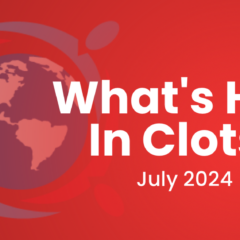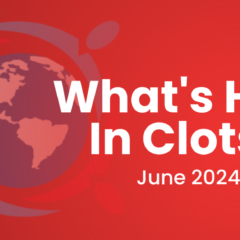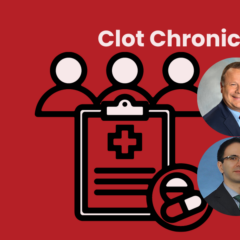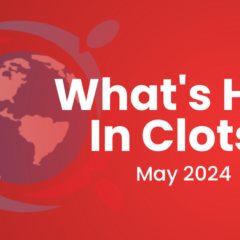Last updated on
What’s Hot in Clots – April 2024
Key Updates in Thrombosis
Table of Contents
- More hope for blocking factor XI?
- History of fibrinolytic therapy: A chance to learn from authors who shaped this history
- Do DOACs have a place for management of patients with CTEPH?
- Very low-dose rivaroxaban and endogenous fibrinolysis in patients with ACS receiving DAPT
- Antithrombotic therapy in patients with GI diseases: Walking a tightrope
My greetings for the beginning of the Spring (and the Persian New Year – called Norooz). Well, it’s not quite springtime in Boston, but still! Here we go with my picks for the month:
More hope for blocking factor XI?
Over the past 6 months, I have covered several articles related to inhibition of factor XI with mixed results. This month, a phase II RCT of 308 patients with renal failure undergoing hemodialysis tested this pathway. Fesomersen, a drug that inhibits hepatic factor XI expression, led to lower factor XI levels and was safe. What does it mean? We need clinical outcomes trials. Read more.
History of fibrinolytic therapy: A chance to learn from authors who shaped this history
Historical perspectives for diseases and therapies help inform how progress was made in the past, with an eye toward future directions. This review of fibrinolytic therapy was particularly special to me, since I got to work with and learn from several experts who shaped the history of using these drugs. I learned from Dr. Braunwald that fibrinolytic therapy was used for the first time for treatment of…make a guess…not myocardial infarction….not stroke…not even PE; but fibrinous pleural adhesions! Read more.
Do DOACs have a place for management of patients with CTEPH?
Results of the KABUKI trial, a small RCT of 74 patients with chronic thromboembolic pulmonary hypertension (CTEPH) who had undergone reperfusion and were randomized to edoxaban versus warfarin, although underpowered, suggested similar efficacy and safety findings with edoxaban compared with warfarin. Read more.
Very low-dose rivaroxaban and endogenous fibrinolysis in patients with ACS receiving DAPT
A prior RCT showed that in patients with acute coronary syndromes (ACS)—most of whom were receiving dual antiplatelet therapy (DAPT) and low-dose rivaroxaban (2.5 mg twice daily or 5 mg twice daily)—resulted in fewer cardiovascular events but an excess in major bleeding and intracranial bleeding. Now, a mechanistic RCT in a similar patient population failed to show improvement in fibrinolysis or clot lysis times with very low-dose rivaroxaban versus no treatment. Read more.
Antithrombotic therapy in patients with GI diseases: Walking a tightrope
Many GI considerations should be kept in mind for antithrombotic therapy. For example, we are asked all the time which antiplatelet or anticoagulant agents can be crushed or administered via a G or a J tube, whether opiates truly impact the outcomes of patients with ACS as a result of delaying the absorption of oral P2Y12 inhibitors, and perhaps most importantly, when and how to adjust antithrombotic regimens in patients with recent GI bleeding or those at high risk of GI bleeding. In a comprehensive review paper by a multidisciplinary team of experts, we address these questions and more! Read more
For more updates, be sure to subscribe to get the latest updates each month.
Find this information helpful? Please consider making a small donation in support of thrombosis education & resources.

Behnood Bikdeli, MD, MS
Cardiologist, Section of Vascular Medicine, Division of Cardiovascular Medicine, Brigham and Women’s Hospital
Investigator, Thrombosis Research Group, Division of Cardiovascular Medicine, Brigham and Women’s Hospital
Instructor, Harvard Medical School
Investigator, Yale/ YNHH Center for Outcomes Research and Evaluation, Yale School of Medicine
Investigator, Cardiovascular Research Foundation



